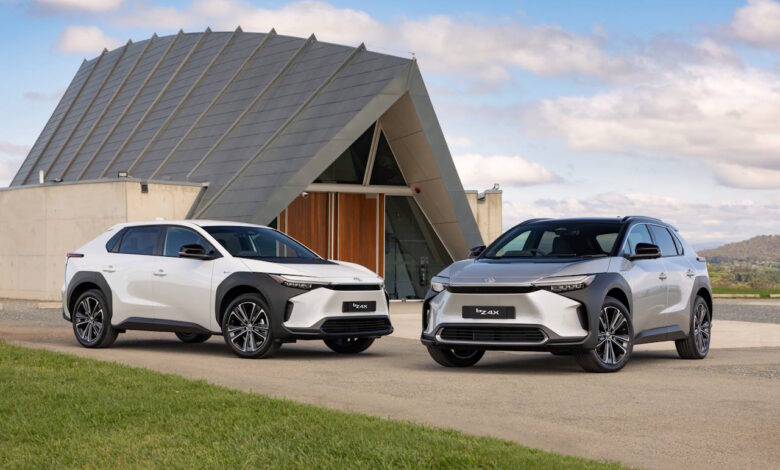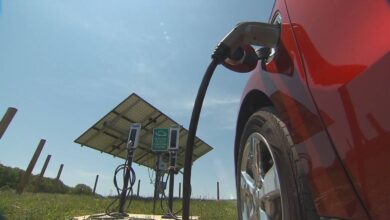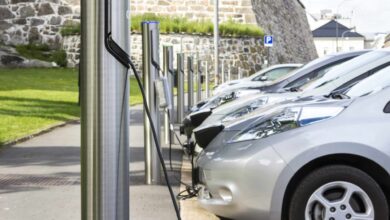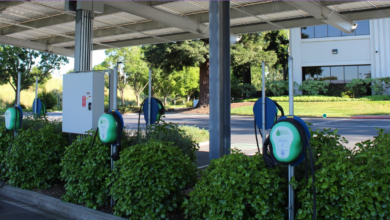Japanese car giant’s first electric offering

Toyota has been very slow to enter the pure electric vehicle market, preferring instead to roll out fuel-sipping hybrid versions of their best-sellers, which to be fair have proved very popular with motorists. But now, finally, there is the bZ4X mid-range SUV which is completely battery powered, and I’ve been driving it.
The bZ stands for Beyond Zero and the ‘4’ on the badge is its size class, and X means it’s a crossover SUV body.
The bZ4X is a similar size to the well-known Toyota RAV4 hybrid, and it seeks to go head-to-head with the Tesla Model Y, Australia’s top-selling electric vehicle, the Hyundai Ioniq 5, Kia EV6 and Ford Mustang Mach-E.
The bZ4X should have been on Australian roads sooner – about 18 months sooner – but a number of delays pushed it back, including a global recall to fix faulty bolts that could cause the wheels to fall off. Thankfully, that has now been solved, so probably well worth the wait…
There are two models in the bZ4X range – a front-wheel drive (FWD) model priced from $66,000 plus on-road costs, and the all-wheel drive (AWD), which I’ve been driving priced from $74,900 plus on-road costs.
Both use the same 71.4kWh lithium-ion battery pack, but the AWD version swaps the FWD’s single 150kW electric motors for dual 80kW motors, and there’s a fair bit of extra equipment added too.
Standard equipment in the front wheel drive model includes 20-inch wheels, LED headlights, a 12.3-inch touchscreen with wireless Apple CarPlay/Android Auto, and satellite navigation, a seven-inch digital instrument display, front and rear parking sensors, a rear-view camera, fabric and leather-look trim, heated front seats, a power-adjustable driver’s seat, six speakers, autonomous emergency braking, lane-keep assist and adaptive cruise control.
The AWD adds blind-spot monitoring, a 360-degree camera, full leather-look trim, ventilated front seats, heated front seats, a nine-speaker JBL sound system, panoramic glass roof, wireless phone charging, a rear spoiler, and X-Mode off-road settings.
The cabin
The first thing to get used to is what at first seems a strange driving position on account of the instrument display which is placed high and relatively far away. The steering wheel is quite small so you are able to place it low and look over it at the instruments, which isn’t as bad as it sounds.
After a few minutes on the road I found it easy to get used to. There are lots of buttons on the steering wheel but important ones like cruise control are easy to find and operate.
The front seats are fairly soft and quite comfortable and they’re supportive in fast bends. Space for the driver is not bad, though the large centre console is wide, cutting into knee room. Having said that, personally I don‘t drive with my legs splayed so I appreciated the cocoon type feel.
There’s eight-way power adjustment for the driver (plus two-way lumbar), six-way manual adjustment for the front passenger, and heating for both front seats, with the AWD model adding ventilated front seats and memory for the driver’s seat.
One design element I’m not too keen on is the shiny piano-black centre console. Yes, it says quality and the smart phone wireless charging port is revealed via a nice soft-touch button release, but that shiny surface reflects light and on a sunny day it’s always playing in the corner of your eye and is a distraction.
There’s keyless entry and start, dual-zone climate control (which is a really good system), two USB-C ports, one USB-A socket, and one 12-volt outlet.
Rear seat passengers get plenty of leg room and reasonable head room – even behind a six-foot-tall driver and the space is genuinely wide, so easily sits three.
There’s also a two-stage reclining backrest, bottle holders in the doors, two USB-C ports, three top-tether points for child seats, two ISOFIX anchors, a fold-down armrest with two cupholders, two map pockets, and rear ventilation.
The rear seats fold 60:40 for longer items, and there is illumination and bag hooks in the boot, but no 12-volt socket. A tyre repair kit is under the floor, but there is no storage compartment under the bonnet, as seen in many rivals.
Boot space itself is pretty good and the load sill is not too high so sliding heavier objects in and out isn’t a problem. There’s an electric powered open and close function for the heavy rear door.
The 7.0-inch instrument display is on the small side, but the basic level of information it displays is clear.
In the centre is a large screen for the sound system and other functions and it works well and looks good too – it all says, quality.
Warranty and servicing
The BZ4X has a five-year/unlimited-kilometre warranty for the vehicle and high-voltage battery.
If you follow the logbook service schedule and have the battery inspected annually by a Toyota dealer you can have the warranty on the electric motor and driveline extended to seven years/unlimited kilometres, and the battery warranty to 10 years.
Toyota warrants the battery pack for 70% of its original capacity remaining after eight years, though the company does say it should be possible, with normal use, to see 90% over that period.
Scheduled servicing costs $180 for the first five services – at 12-month or 15,000km intervals, whichever comes first – adding up to $900 over five years/75,000km.
Toyota claims energy consumption according to European WLTP testing standards of 8.1kWh/100km in the AWD, with a claimed driving range of 411km with a full charge.
Driving
For a heavy vehicle – it tops out at around two tonnes – the steady stream of power is remarkable and puts a smile on your face. Put your foot down and there’s instant torque and the bZ4X doesn’t disappoint, it sprints past other vehicles.
Plant your right foot and it goes like the clappers. This makes overtaking a breeze and really the only thing to watch is your speed because that climbs quickly.
The active cruise control works well and when you approach, say, one of those 85kph bend signs, it slows you down. Now me, I rarely slow down for those unless the road is wet so I personally found that a bit of a nagging feature. Still, it gets a tick for safety.
The driver alert system also works well – look out the side window and a chime goes off. It’s not a loud one so it doesn’t bother you too much (and obviously you should have your eyes on the road anyway), but it’s definitely good to have.
The suspension is on the firm side, and provides a good balance between comfort and control. This vehicle corners flatly and the steering has plenty of feel.
There’s very little body roll and good grip from the Bridgestone Alenza (235/50 R20) tyres.
The absence of a petrol or diesel engine means you do hear tyre rumble, even a bit of a roar on the large-chip roads across our region, and there is bit of wind noise from the mirrors at highway speeds, but honestly overall it’s a very quiet vehicle.
Off road
The BZ4X is not a Toyota HiLux or LandCruiser. It’s lower to the ground for starters – but it is capable off-road and can certainly take farm tracks and a good deal of other rough stuff in its stride.
The all-wheel drive version comes with 212mm of ground clearance and two X-Mode off-road drive settings which includes a very well-calibrated hill-descent control and a dial-in off-road cruise control system to suit whatever conditions you’re travelling over.
The Toyota BZ4X is available for purchase outright, through conventional finance, or through a Full-Service Lease program that includes insurance, servicing and registration costs in one monthly payment.
Tony Bosworth was founding editor of Which Car? deputy editor of What Car? and founder of Practical Motoring. He has written on automotive business for the Financial Times, the Times, Independent, Guardian, and the Bulletin, among many other publications, and has spoken about motoring issues on the ABC and BBC and had his own motoring radio show for six years. He is the author of five non- fiction motoring books.
Tony Bosworth writes for www.TheDriven.io and RenewEconomy.com.au. He has 35 years experience in journalism, and has been instrumental in launching and editing several automotive magazines including Which Car? magazine in the UK.



